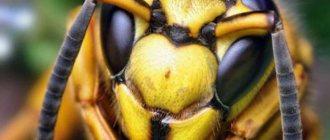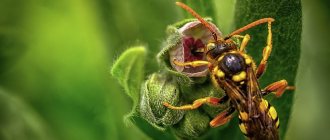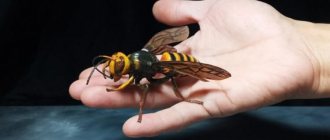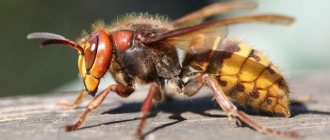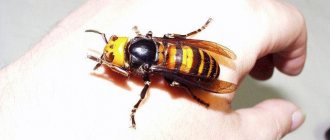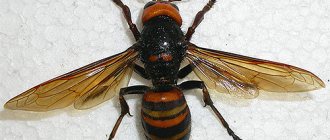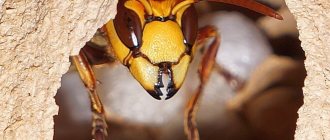The black hornet, or Dybovsky's hornet, is considered a rather rare species compared to some other types of these insects. On the territory of our country they can be found in the Amur region and Transbaikalia. In general, they are also found in Japan, India, Burma, Thailand, Korea and China.
Even in its main habitat areas, this hornet does not live in large numbers. This species does not build its own nests, so their massive presence anywhere in one place is usually not observed. Perhaps this was the reason for its rare and small population. However, the lifestyle of these insects explains a lot.
Habitat and lifestyle
The Dybovsky hornet is considered the rarest insect in Russia. Its numbers are small. You can meet him in Transbaikalia, and if you’re lucky, in the Amur region. The most common dipteran is in China, Thailand, Japan, and Korea.
This is interesting! The black hornet is able to penetrate and take over the nest of smaller relatives.
In general, if you look at the habitat, it cannot be said that there are very few insects. They just can live in favorable environments to increase their numbers. This species is widespread in Asia. The insects are rare in Europe. The behavioral characteristics of insects make them few in number in any particular habitat. Hornets have a stable population.
The only nest parasite among its brothers
The most important and especially interesting feature in which black hornets differ from other hornets is their way of life. Of all 23 species of its fellows, the black one is the only nest parasite.
At the end of summer, a young female finds a fairly overgrown nest of common or medium-sized Japanese hornets, penetrates it and kills the queen.
After this, the female invader, using special pheromones, disguises herself as family members, whose individuals, guided by smell, immediately recognize her as their queen. Despite the fact that the new resident of the nest belongs to a completely different species, the workers, confused by her smell, begin to serve the new queen with the same zeal.
After capturing the nest, the female black hornet immediately begins to lay pre-fertilized eggs, from which individuals are then hatched that are already capable of reproduction. Thus, throughout the entire development of the larvae of one species, they are nurtured by misled workers of another.
When the number of females and males becomes sufficient, they leave the nest and mate. The males soon die, and the females find places for wintering or, if it happens in the tropics, new families for parasitism.
In the photo there is a black hornet on the bark of a tree:
It is worth noting that capturing a nest, despite the simple algorithm, is not easy for female black hornets. The vast majority of them die at the “hands” of working individuals who zealously defend their home.
Until the old queen is killed, the new one is never recognized in the family. However, those rare lucky ones who manage to win the nest ensure the appearance of such a number of young individuals that more than covers the death of the less fortunate sisters.
It is clear that single females looking for a nest are not seen as often as, say, numerous working individuals of a large family. That is why, even in their usual habitats, black hornets, unlike hornets of other species, are not considered widespread.
In exceptional cases, these insects can organize their own nests and live in families. This behavior manifests itself extremely rarely and is explained primarily by the fact that in some places of the hornets’ range there may not be other small species at all. In this case, the search for an object for parasitism will definitely end in failure, and even the likely presence of larger species of hornets on the territory will not save the situation: black hornets are not capable of parasitizing on relatives such as giant hornets.
It is also useful to read: What to do if you are bitten by a hornet and how dangerous it can be to your health
Nutrition and reproduction
Adults feed on the nectar of flowers and can attack someone else's hive in search of food. They also love ripe berries and fruits, sometimes making them unsuitable for further use.
The new offspring eat differently. Animal protein is needed for their development. Adult insects catch various flies, small wasps and bees for their larvae. Then they chew all this, and give the resulting food to the larvae. Those, in turn, secrete a substance with a sweet taste in the form of droplets that hornets like.
This is interesting! A special feature of the black hornet is its ability to live and develop in other people's nests.
In the autumn, the female begins to look for a home for breeding new offspring. She watches tree insects and selects a smaller species, after which she attacks the queen. If she manages to win the battle for her place of residence, then she gets new hornets with dark brown or blue wings. However, there may be many soldier hornets in the nest, which fiercely defend their queen's right to rule the colony.
After a change of owner, the new individual secretes special substances that help it disguise itself as a dead insect. The worker hornets mistake her for their queen and continue to live in the hive as usual.
Next, the female lays eggs, from which larvae later emerge. Working insects feed them until they grow into adults. Later mating occurs, and some of the hornets die. Females leave the destroyed nest and go in search of a new home.
It is not often that you see hornets building their own home and living in peace and harmony. This is possible if there is no other nest in the area that can be occupied. With a long search, mass death of hornets can occur.
Life cycle
The lifestyle can be called parasitic.
Place
In autumn, the female looks for other people's nests. The female individual selects the smallest representatives and attacks their uterus, killing it.
Starting a family
The queen disguises herself as the murdered queen. This is possible due to the release of a special substance. The workers consider her to be the queen. She successfully runs the colony. If there are a sufficient number of soldiers in the nest, then the female may not achieve her goal; she will not be allowed to take over someone else’s place.
Appearance of larvae
The queen lays eggs either in a newly created nest or in the one she entered. After a while, larvae appear. Working hornets obtain food for their offspring. The larvae form and the mating period begins. After this, some of the individuals die.
What does a hornet look like?
Visually, scolias are very similar to hornets: they have the same dark color and belong to the same family. Its main difference from an ordinary representative of the family is its color. But what about the Dybovsky hornet, because it also has a dark body color. Scientists say that large scolius has two transverse orange stripes on its abdomen. However, not everyone knows this feature and therefore can confuse insects.
Quite often, scolias are mistaken for a hornet. The optimal length of scolius is 45 mm, but sometimes it reaches 60 mm. There is no need to navigate by the length of the insect.
Scolia gigantea - a wasp from the Red Book
Description of the species
Black hornet.
Body size is from 1.8 to 3.5 cm. In rare cases, it can reach 5 cm. The insect has a black body color and dark wings. The wings come with a blue tint.
At the end of the belly there is an ovipositor. It performs the function of a sting. The difference from its relatives is the absence of transverse stripes and a completely dark body. There are no yellow spots on the body.
Hornet danger
Knowing what a black hornet looks like can help you avoid encountering it. An insect bite is much more painful than an ordinary one. If we compare the black with the Asian, the latter type causes much more pain and consequences from the bite. The Asian hornet is a large insect with a painful sting that can cause tissue swelling (Vespa Mandarinia: royal murder hornet (Asian) is written in more detail in the article here). The venom of the Asian hornet is toxic.
If a colony of such insects attacks a person, this can lead to adverse consequences. The reaction from a bite can vary. The composition of the black hornet's venom differs from that of the ordinary one. The toxicity of the black hornet is much lower than that of the Asian hornet.
The poison contains the following components:
- bradykinin;
- histamine;
- antigens;
- formic acid.
The hornet itself does not attack a person just like that. This usually occurs when the hive is damaged by humans. You should not touch the hornets’ home if they suddenly settled in your summer cottage. After the main housewife leaves the house, it can be removed. A hornet can sting several times.
What not to do if bitten
If you have suffered from a hornet bite, do not try to take revenge on it by killing it, since in stressful situations the insect released releases substances that attract other representatives.
In addition, it is necessary to avoid consuming alcoholic beverages on the day of the bite, since alcohol dilates blood vessels, which leads to rapid penetration of poison into the blood. To prevent infection and inflammation of the skin, do not scratch the wound or treat it with water from a natural reservoir.
First aid for bites
If no reaction appears in the first hours after the bite, then medical procedures can be avoided.
If unfavorable symptoms appear, it is advisable to perform the following actions:
- Treat the bite site with hydrogen peroxide, a solution of potassium permanganate and ammonia prepared in a ratio of 1:5. If this is not at hand, you can rinse with plenty of water.
- To prevent rapid absorption of the venom, apply ice or a cooling pack to the bite site. You can also fill a heating pad with ice water and apply it to the affected area.
- To eliminate the appearance of too strong painful sensations, the bite site is sprinkled with acetylsalicylic acid powder. You can also use herbal ingredients: plantain leaf, dandelion juice, parsley root or leaves. Applying a piece of onion to the affected area also helps.
- If you are bitten by an insect, drink as much fluid as possible. It is advisable to drink clean still water.
Lifestyle
Hornets of any kind can attack a hive. Bee honey and syrup are no less suitable for food than flower nectar. Hornets themselves do not produce honey.
Someone else's nest
Representatives of the species Vespa Dybowskii are able to parasitize:
- In the spring, the fertilized female queen ends up in the nest of other insects (Crabro or Simillima) and she kills the current queen.
- Without destroying the old hornets, the new species of hornets displace the population in the nest;
- Males and new queens hatch in the fall.
- By winter, the males die, and each fertilized female finds a refuge where she lives until spring.
There is no honey inside the nest in winter, and the female queen also dies.
Selection
Hornets usually attack bees in the fall, and not always, but only when there is a reduction in food. The attack is aimed at old or sick bees. That is, the hornet and the bee are not at all enemies of each other. So says beekeeper from the Mtsensk region Dmitry Karpukhin, who has a nest with hornets in his apiary.
Of course, predatory species contribute to selection. But predatory insects themselves can be taught to feed on pollen. It will become the main source of protein. In general, Dmitry strives to breed hornets with vegetarian tendencies. And honey is not used for feeding!
Symptoms and consequences of a bite
After a bite, the following symptoms are possible:
- throbbing severe pain;
- cardiopalmus;
- feeling of shortness of breath;
- severe itching.
Also, in more sensitive people, swelling of the mucous membranes and headache are added to these symptoms. Quincke's edema is possible, although it is rare.
Providing first aid
Even an unqualified person can provide assistance.
You just need to follow these steps:
- Place ice on the bite site.
- To avoid an allergic reaction, give the victim anti-allergy medications. These are Cetrin, Suprastin or Tavegil tablets. To provide a faster effect, it is better to administer the antihistamine intramuscularly.
- Carefully monitor the victim; at the slightest development of severe swelling, you must call an ambulance.
Allergic reaction
All people react differently to the penetration of foreign substances into the body. A person may develop a response despite being in good health.
Approximately 6% of the population develops anaphylactic shock after being bitten. This condition requires mandatory medical care.
Allergy symptoms:
- severe reaction to the bite;
- swelling of soft tissues and mucous membranes;
- anaphylactic shock.
Who can be confused with?
The “black” and “eastern” species of insects have the same body shape, but different colors. The habitats do not overlap: the species Vespa Orientalis, that is, the eastern hornet, lives west of the Urals.
Oriental
The Ural mountain range is home to a single species of hornet called Vespa Crabro. Details are covered in Chapter 1.
Typical mistakes:
- The great red hornet is either a Vespa Mandarina, the largest species, or the queen eastern hornet Orientalis. Area: in the first case - the Far East, in the second - the west.
- The blue-winged black hornet is not a member of the genus Vespa, but a species of solitary bee. Name: carpenter, carpenter bumblebee, Xylocope.
Of the above mentioned species, two species are listed in the Red Book - Xylocopa Violacea and Vespa Dybowskii. However, representatives of all species can sting. But on condition that the individual is not a male.
Alert
Common hornets are social insects and are capable of stinging an enemy in an entire nest for defense purposes. This is dangerous for animals and humans. If someone threatens the hive, the insect releases an alarm pheromone, a substance that calls other hornets to attack.
You should not destroy the hornet near the hive, as a result of which the pheromone will rebel the swarm to attack the offender. Tissues that come into good contact with the pheromone also serve as a signal for an attack: clothing, skin, inanimate hornets and their prey, food seasonings, banana and apple fragrances containing alcohols and ethers.
Appearance and structure of Vespa Mandarinia
In general, the appearance and body structure of the Asian giant murder hornet are very similar to the characteristic features of representatives of all 23 species of these insects. They resemble wasps in color, but differ from them in size and lifestyle.
You can distinguish the Asian hornet from all other insects by the following striking features:
- Incredibly large size, reaching a ratio of body length and wingspan of 5x7 cm. An adult insect with outstretched wings almost completely covers a woman’s palm and at first glance seems like a plastic toy.
- The abdomen (back part of the body), painted in alternating black and yellow stripes, appears black from a distance because the dark stripes are wider than the light ones.
- The chest (middle part of the body) is very dark, with a characteristic black pattern.
- The head (front part of the body) is most often a rich yellow or orange color, which allows you to notice the insect from afar.
- The paired lateral eyes are very large, deep dark in color, almost black.
In addition to the large lateral eyes, in the center of the front part of the hornet’s head there are three additional ones, thanks to which the insect distinguishes the degree of illumination and is perfectly oriented in space. The Asian hornet sees well even in the dark.
The appearance of the giant insect is very remarkable; the hornet is difficult to confuse with other species or not to notice. But, given the high speed that it can develop when flying, bright identifying signs are not always enough to avoid an unpleasant meeting with the killer, as this eastern giant is also called.
A disaster for humans or a decoration of nature
In a global sense, giant Asian hornets are, of course, dangerous to people, but this danger is not critical, since it is entirely provoked by man himself. These insects are not very aggressive by nature; they will only attack in self-defense or protecting a nest.
Photo 14.
Hornets cause much more damage to apiaries, especially those where less aggressive European honey bees are bred. Sometimes hornets manage to destroy an entire bee family in a few hours, and therefore local beekeepers wage an ongoing systematic fight against them.
In general, the mortality rate from giant hornet bites is quite high: in some regions, up to 100 people die per year. But in fairness, it should be said that most of the dead are the same beekeepers who, without special means of protection, actively destroy hornet nests and, as a result, fall under their massive attacks.
A simple tourist who accidentally finds himself in the forest next to the Vespa Mandarinia hornet should not be afraid of this insect - it will not attack without a reason.
Photo 15.
In the West, many dietary supplements add synthetic substances similar to the secretion contained in developing hornet larvae. These components are believed to increase human endurance. However, there is no experimental evidence for these claims.
In conclusion, it should be noted that for wildlife, giant hornets are one of the most active natural orderlies. They successfully destroy many forest and agricultural pests, therefore, in most biocenoses - including agricultural lands - they are useful and deserve protection.
Photo 16.
Photo 17.
Photo 18.
Photo 19.
Photo 20.
Several dozen hornets completely destroyed a bee hive
https://youtube.com/watch?v=t6gpCqWgaBc%3Fwmode%3Dopaque%26wmode%3Dopaque
https://youtube.com/watch?v=CkZInqR3Qb0%3Fwmode%3Dopaque%26wmode%3Dopaque
sources
https://klop911.ru/shershni-i-osy/shershni/shershen-vespa-mandarinia.html
Huge Asian Hornet
Asian giant hornet (lat. Vespa mandarina)
The original article is on the website Link to the article from which this copy was made.
How do they reproduce and how long do they live?
The queen, hibernating in the cold, finds a place in the spring that is suitable for a nest and lays her eggs there. She then looks for food and looks after her future inheritance.
After about thirty days, hornets emerge from the larvae, and it is possible that the queen will be expelled from the nest, or eliminated, because she can no longer lay eggs.Newly born members of the community take care of the future arrangement of the nest and feeding the queens and larvae. This type of scheme causes the community to grow incredibly quickly.
As for the duration of the hornets’ life cycle, it only reaches a couple of months. We are talking about working insects.
But the queen can live longer due to the ability to withstand severe frosts well, thanks to hibernation.
Hunting tactics of giant hornets
All months, from spring to colder weather in autumn, from early morning to late evening, Asian hornets hunt to obtain food for the larvae developing in the nest. Flying through the forest, scouts look for small insects, as well as bee hives. Having discovered them, they mark them with a special substance containing odorous pheromones. The attractive aroma attracts worker hornets, which kill the entire population of the colony and take away the honey and larvae.
On a note!
According to scientists, in one hunting operation, aggressive “conquerors” can destroy a colony of 30 thousand bees. However, the inhabitants of the hive do not always give up without a fight; sometimes they manage to kill the scout before the signal is given and can save their offspring from death. To do this, they lure it inside the hive, where, using vibration of the wings, they increase the air temperature to +50ºС, which causes overheating and death of the scout hornet.
For a lone insect caught on the road by a “hunter”, there is no way to escape. When attacked, the predator manages to quickly inject a paralyzing poison, and then chews the prey with its powerful jaws. It only takes a few seconds to decapitate a praying mantis, which is larger than an Asian wasp.
How to get rid of hornets
There are three ways to get rid of hornets:
- hang traps to catch insects,
- destroy nests by burning,
- destroy families using chemical means.
The safest method of control is the use of traps, but, nevertheless, it is not a fact that after their use the insects will be completely exterminated.
Hornet trap
It is simply a device that is designed to catch and hold bumblebees. Hornets are caught using bait. There are many traps currently sold on the market, but the following stand out:
- Argus Garden.
An affordable means for catching hornets and wasps, which is a plastic container with a lid and a string. To use it, open the lid and fill it with bait, which can be beer, honey diluted with water, or sugar syrup, and then place it at a distance of 20 to 25 meters from the hornet.
20 meters is the minimum safety zone. If you get closer, the hornets will attack.
It is designed in such a way that the hornets freely penetrate inside and cannot get out. The trap is checked after 3-4 days.
- Wasp Trap SWISSINNO.
Supplied complete with bait made from natural ingredients, which attracts hornets with a natural scent. Before catching insects, bait is placed in a container and filled with water to a special mark, and then shaken so that the components interact.
It is designed for repeated catching of hornets in the early morning or late evening, which are the optimal and most productive time for this type of activity.
- Homemade trap.
The most popular option among summer residents and apiary owners is a homemade hornet trap. It is made as follows:
- Take a used drinking water bottle of any size.
- Cut off 1/3 of the top of the bottle.
- The edges are greased with oil or Vaseline.
- Turn it upside down and insert it at the cut site.
- Cuts are made along the edges and special inserts from Argus Garden are inserted, which vaguely resemble flowers and additionally attract bumblebees.
- Fill the bait with fermented raspberry jam, grapes, a beer drink with honey and sugar, or water in which rotten fish was lying.
Inserts are used exclusively to increase fishing efficiency; if they are not available, then you can do without their use.
The best time to catch hornets
The best time to catch hornets is from the end of May to the beginning of June, since at this time young individuals fly in search of a new home and a place to lay eggs. If you catch a young queen, or maybe more than one, the risk of the appearance of a beetle in the area becomes much less. For better results and increased productivity, traps are installed throughout the area at a distance of 20–25 cm, far from pedestrian areas.
Traps are cleaned using aerosols against hornets and wasps, spraying them into the cavity where the insects are kept, and only after all individuals have died.
Video: hornet trap
Are they beneficial or harmful?
All hornets destroy harmful insects. And they all sometimes hunt bees. In general, insects of the Vespidae family are predators. And they are almost useless as pollinators, unlike bumblebees or osmia.
Interesting Facts
Below is how long each hornet lives.
In the nests of Vespa Crabro insects the number of individuals is 300-400, and the Simillima species organizes families of 1000-2000. The families of each of the two species are parasitized by the species Vespa Dybowskii. How the nest is constructed was discussed above.
The material used to build the nest is saliva and wood debris.
